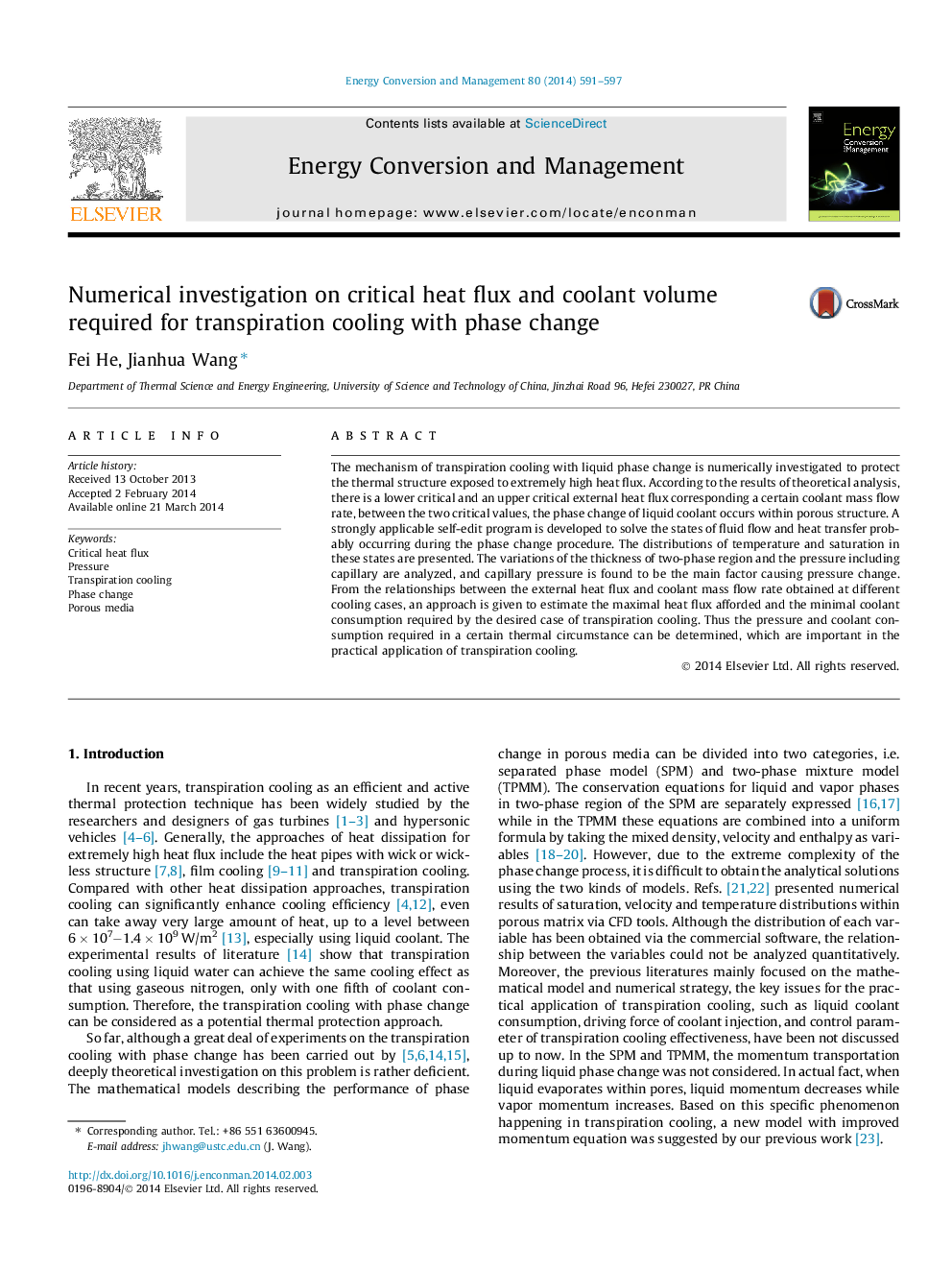| کد مقاله | کد نشریه | سال انتشار | مقاله انگلیسی | نسخه تمام متن |
|---|---|---|---|---|
| 7165362 | 1462882 | 2014 | 7 صفحه PDF | دانلود رایگان |
عنوان انگلیسی مقاله ISI
Numerical investigation on critical heat flux and coolant volume required for transpiration cooling with phase change
ترجمه فارسی عنوان
بررسی عددی روی شار گرمای بحرانی و حجم خنک کننده مورد نیاز برای خنک شدن تعرق با تغییر فاز
دانلود مقاله + سفارش ترجمه
دانلود مقاله ISI انگلیسی
رایگان برای ایرانیان
کلمات کلیدی
ترجمه چکیده
مکانیزم خنک سازی تعرق با تغییر فاز مایع به صورت عددی برای حفاظت از ساختار حرارتی در معرض شار حرارت بسیار بالا مورد بررسی قرار گرفته است. با توجه به نتایج تجزیه و تحلیل نظری، یک بحران بحرانی بحرانی بحرانی و فوقانی بالایی از جریان گرما خارجی مطابق با جریان جریان جرمی خنک کننده وجود دارد، بین دو مقدار بحرانی، تغییر فاز خنک کننده مایع در ساختار متخلخل رخ می دهد. یک برنامه ویرایش خودکار قوی برای حل حالت های جریان سیال و انتقال گرما احتمالا در طول فرایند تغییر فاز بوجود می آید. توزیع درجه حرارت و اشباع در این حالت ها ارائه شده است. تغییرات ضخامت ناحیه دو فاز و فشار شامل مویرگی تحلیل می شود و فشار مویرگی عامل اصلی تغییر فشار است. از رابطه بین شار حرارتی خارجی و جریان جرمی خنک کننده به دست آمده در موارد خنک کننده مختلف، روشی برای تعیین حداکثر شار حرارتی ارائه شده و مصرف کم خنک کننده مورد نیاز در مورد دلخواه از خنک کننده ترانسپیراسیون داده می شود. بنابراین مصرف فشار و خنک کننده مورد نیاز در یک شرایط حرارتی خاص می تواند تعیین شود، که در کاربرد عملی سرد شدن ترانزیت مهم است.
موضوعات مرتبط
مهندسی و علوم پایه
مهندسی انرژی
انرژی (عمومی)
چکیده انگلیسی
The mechanism of transpiration cooling with liquid phase change is numerically investigated to protect the thermal structure exposed to extremely high heat flux. According to the results of theoretical analysis, there is a lower critical and an upper critical external heat flux corresponding a certain coolant mass flow rate, between the two critical values, the phase change of liquid coolant occurs within porous structure. A strongly applicable self-edit program is developed to solve the states of fluid flow and heat transfer probably occurring during the phase change procedure. The distributions of temperature and saturation in these states are presented. The variations of the thickness of two-phase region and the pressure including capillary are analyzed, and capillary pressure is found to be the main factor causing pressure change. From the relationships between the external heat flux and coolant mass flow rate obtained at different cooling cases, an approach is given to estimate the maximal heat flux afforded and the minimal coolant consumption required by the desired case of transpiration cooling. Thus the pressure and coolant consumption required in a certain thermal circumstance can be determined, which are important in the practical application of transpiration cooling.
ناشر
Database: Elsevier - ScienceDirect (ساینس دایرکت)
Journal: Energy Conversion and Management - Volume 80, April 2014, Pages 591-597
Journal: Energy Conversion and Management - Volume 80, April 2014, Pages 591-597
نویسندگان
Fei He, Jianhua Wang,
